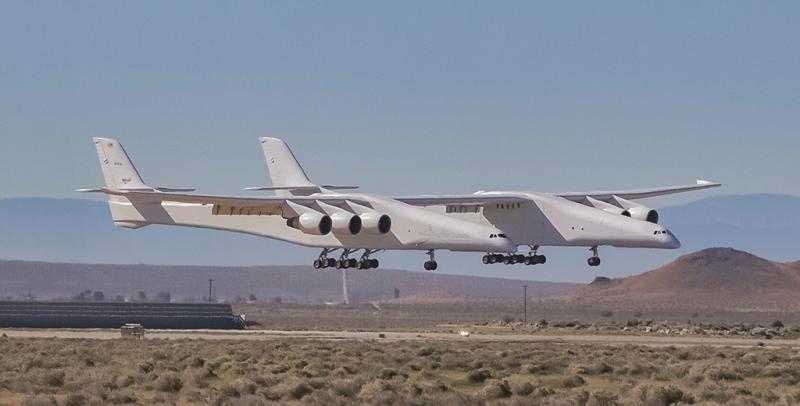
LOS ANGELES—As Stratolaunch continues preparations to restart flight tests of its giant carrier aircraft next fall, the company has unveiled new details of the rocket-powered hypersonic vehicle fleet it plans to deploy for high-speed flight research and development.
Although originally conceived primarily for air-launching medium class rockets, Stratolaunch has been repurposed to focus on the growing needs of the U.S. defense industry for reliable access to Mach 5-plus test conditions. Stratolaunch, under its founder the late Paul Allen, first outlined plans to provide airborne hypersonic test platforms in 2018. The latest revelations show how this strategy continues to evolve under Cerberus Capital, which took over the company in 2019.
The initial flying testbed, Talon-A, is a fully reusable, autonomous, liquid rocket-powered vehicle targeted at flight speeds of around Mach 6. Derived directly from the Hyper-A concept unveiled two years ago, the sharply swept delta wing aircraft shares the same 28-ft. length and 11.3-ft. wingspan. But it is now configured with a single vertical tail fin in place of the wingtip-mounted canted fins on the original design. Launch weight similarly remains at around 6,000 lb. and, as before, the vehicle will be capable of recovering for an autonomous horizontal landing as well as being able to take off horizontally under its own power.
Updated renditions indicate up to three Talon-A vehicles could be carried aloft beneath the Stratolaunch carrier aircraft using a version of the pylon adapter configuration developed originally for launching smaller rockets. This included the Northrop Grumman Pegasus XL, which was to have been used for proving the platform’s initial air launch capability. Stratolaunch says missions with single aircraft drops are due to start in 2023 and, according to information on its website, suggests that follow-on near simultaneous multiple launch capability “may support specific operational scenarios.”
Another vehicle, the Talon-Z, will also be offered. Like the original Hyper-Z, this will be a basic scaled-up version of the Talon-A. Although no details of the updated vehicle have been provided, a new rendition also indicates a single fuselage-mounted vertical fin in place of the Hyper-Z’s wingtip-mounted fins. Under Stratolaunch’s original plan, the follow-on derivative was to be significantly larger, with an overall length of 80 ft. and a 36-ft. wingspan.
The more capable “Z” version is expected to target test conditions up to Mach 10 and, with an all-up weight of 65,000 lb., will offer longer duration flights, which could potentially see the vehicle boost to 500,000 ft. altitude and cover ranges up to about 800 nm. Stratolaunch is not discussing a timeline for the second vehicle. But under its original plan, estimated tests of the follow-on derivative could come within five years of the “A” model. Under the latest schedule this could mean Talon-Z could make its test debut by around 2028.
The two vehicles will be able to carry both internal and external payloads, the latter including bolt-on propulsion or flow-path experiments as well as fin-like structures for boundary layer transition and other investigations. The company’s new Talon-A graphic shows a variety of internal and external locations for experiments, including self-contained volumes in the nose and mid-fuselage, with standardized interfaces for power for smaller tests. Others include wing leading edge experiment sites and a belly-mounted location for testing inlets and other flow-path investigations.
Initial design of the Talon is believed to be relatively well-advanced based on preliminary work already conducted by the company. A 3.5-ft.-long model of the original concept was tested in 2018 in the 4 x 4-ft. subsonic wind tunnel at the U.S. Naval Academy in Annapolis, Maryland, which provided initial data on characteristics for approach and landing. It is unknown whether a series of follow-on high-speed tests scheduled to take place at NASA Marshall Space Flight Center’s tri-sonic facility in late 2018 and early 2019 were conducted as planned.
Stratolaunch is also officially resurrecting the longer-term Black Ice spaceplane project which will build on the Talon design to offer an air-launched space shuttle-like capability to orbit. The concept, which also emerged in 2018, would be a “fully reusable spaceplane that enables advanced on-orbit capabilities and cargo return,” the company says.
In terms of powering the Talon and follow-on vehicles, Stratolaunch says it “is working with engine providers to procure the rocket engine. We will disclose our engine provider when we have more news to share.” Longer term, the company also appears to be holding the door open to potentially resurrecting the PGA liquid rocket engine it was developing to power the new vehicle family. In January 2019 Stratolaunch announced it was abandoning development of a proposed space launch vehicle that would also have been powered by the PGA engine. At the time, preliminary development of the engine was progressing at NASA’s Stennis Space Center. Commenting on the possibility of restarting the PGA program, the company says only that “long-term development plans will be disclosed at a later date.”
[Editor's Note: This story was amended to correct the dimensions of the Talon-A.]





